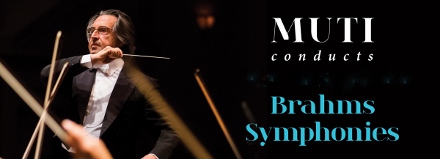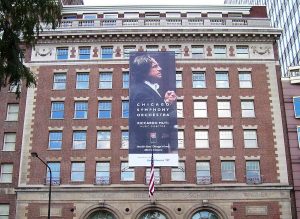MUTI AND THE CSO BRING
BRAHMS SYMPHONIES TO DISNEY HALL
Endlessly frustrating his admirers, Johannes Brahms was well-known for his reluctance to begin symphonic works. Once he began—with the arrival of his First Symphony in 1876—the floodgates swung open. The First took about 15-21 years to finish (depending on which scholar you ask), but the Second—reflecting Brahms’ summer in an idyllic lakeside town—was composed within a year. The Third, written in 1883 after a six-year period which produced some of his best work (Violin Concerto; Piano Concerto No. 2), was completed in just one summer (this Symphony, the shortest of the cycle, is Brahms at his most personal and introspective). His Fourth, and final Symphony was begun the following year.
Now, directly on the heels of two programs devoted to Brahms’ symphonies, Riccardo Muti and the Chicago Symphony Orchestra are coming to Disney Hall to offer the Second and Third Symphonies. But you only have one shot, Sunday, October 22 at 7:30, before this prestigious outfit goes back home after a nine-concert tour.
CSO program annotator Phillip Huscher tells us that the Windy City orchestra has a formidable history of playing Brahms’ symphonies. The orchestra performed the Third Symphony in April 1892, on the final concert of its very first season, and Theodore Thomas, the Orchestra’s founder and music director, introduced the others, one by one, in each of the next three seasons. Both Thomas and his successor, Frederick Stock, placed Brahms’ orchestral music at the heart of the Orchestra’s growing repertoire. In fact, for eighty-three consecutive seasons, there was at least one symphony by Brahms featured every year.
Back in 1904, one of Daniel Burnham’s original designs for Orchestra Hall had Brahms, dead only ten years, in the names of five composers which were incorporated just above the tall arched windows on the second floor. Yet even though three of Brahms’ symphonies and his Violin Concerto were programmed that same year, the obvious skittishness of memorializing Brahms won out, and it is now Schubert’s name that appears alongside Bach, Mozart, Beethoven, and Wagner.
Brahms biographer Jan Swafford wrote, “Despite the resistance he found to his symphonies, their influence on composers was still pervasive and historic. While he was working on the First, the genre was actually verging on moribund, never having regained the heights Beethoven brought it to. From the First to the Fourth symphonies, Brahms virtually revived the genre, paving the way for generations of symphonists to come: Mahler, Sibelius, and a long list beyond.”
The composer’s presence in Chicago’s musical life has not diminished since the opening of what is now known as Symphony Center. Year after year, generation after generation, Brahms continues to sit at the heart of the Chicago Symphony Orchestra’s musical life: not one of the Orchestra’s 126 seasons has passed without Brahms’ music on its programs.
photos courtesy LA Phil and CSO (Symphony Center WikiMedia)
Chicago Symphony Orchestra
Riccardo Muti, conductor
presented by the Los Angeles Philharmonic
Brahms Symphonies 2 and 3
Walt Disney Concert Hall
Sunday October 22, 2017, at 7:30
for tickets, call 323.850.2000 or visit LA Phil





